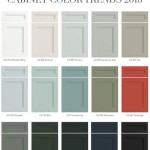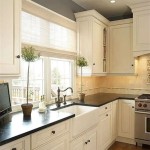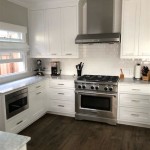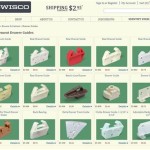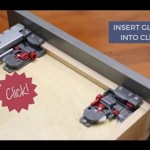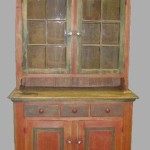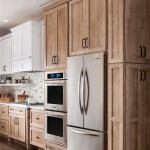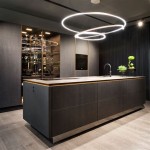Refinishing Kitchen Cabinet Kits: A Comprehensive Guide
Kitchen cabinets often represent a significant portion of a kitchen's overall aesthetic and functionality. Over time, wear and tear, outdated styles, or simply a desire for a fresh look can diminish their appeal. While replacing cabinets entirely can be a substantial investment, refinishing presents a more budget-friendly and practical alternative. Refinishing kitchen cabinet kits offer a convenient and organized way to undertake this project, providing many of the necessary materials and instructions within a single package. This article aims to provide a comprehensive overview of refinishing kitchen cabinet kits, exploring their components, advantages, disadvantages, and considerations crucial for a successful refinishing endeavor.
The term "refinishing" refers to the process of restoring the existing finish of the cabinet doors and frames. It involves preparing the surface by cleaning, sanding, and potentially stripping the old finish, followed by applying new coats of stain, paint, or a clear protective coating. Refinishing techniques are different from refacing, which involves replacing the cabinet doors and drawer fronts while keeping the existing cabinet boxes; or replacing, which involves complete removal and installation of new cabinets.
Refinishing cabinet kits cater to various skill levels, offering pre-selected materials designed to work cohesively. These kits can benefit both experienced DIYers and homeowners who are new to refinishing projects. Understanding the elements included in a kit and the steps involved in the refinishing process is paramount for achieving professional-looking results.
Key Components of Refinishing Kitchen Cabinet Kits
The contents of a refinishing kit can vary depending on the manufacturer, the desired finish (e.g., stained or painted), and the size of the project. However, several core components are commonly found in most kits:
Cleaning Solutions: These are specially formulated cleaners designed to remove grease, grime, and other contaminants from the cabinet surfaces. Proper cleaning is essential for ensuring that the new finish adheres properly. Degreasers are frequently included to tackle stubborn oily residues that accumulate in kitchens.
Sanding Supplies: Sandpaper of varying grits and sanding blocks or sponges are usually included. Sanding is crucial for creating a smooth, even surface that promotes optimal adhesion of the new finish. The kit may offer different grits of sandpaper, from coarse grits for removing the old finish to fine grits for smoothing the surface after priming or painting.
Primer: Primer is a preparatory coating applied after sanding and before applying the final finish. It serves several purposes: it seals the wood, helps the finish adhere better, provides a uniform surface for the finish, and can block stains from bleeding through. Kits frequently include high-quality primers that are specifically designed for use on wood cabinets.
Paint or Stain: The kit will contain either paint or stain, depending on the desired finish. Paint kits often include high-quality acrylic or latex paints that are durable, washable, and resistant to chipping and fading. Stain kits will contain wood stain in a specific color, allowing the natural grain of the wood to show through. The quality and quantity of the paint or stain are important considerations when selecting a kit.
Topcoat (Clear Coat): A topcoat or clear coat is applied over the paint or stain to protect the finish and enhance its durability. Topcoats can be available in different sheens, such as matte, satin, semi-gloss, and gloss, allowing the homeowner to customize the final appearance of the cabinets. Polyurethane and acrylic topcoats are common options, offering resistance to scratches, moisture, and chemicals.
Application Tools: The kit may include essential application tools, such as paint brushes, rollers, paint trays, and rags. The quality of these tools can impact the final finish. For example, using a high-quality brush can help minimize brush strokes and ensure a smooth, even application.
Instructions: Detailed instructions are a crucial component of any refinishing kit. These instructions should provide step-by-step guidance on the entire refinishing process, from preparing the cabinets to applying the final coat. Clear and concise instructions can help ensure a successful project, especially for those who are new to refinishing.
Some kits may also include additional items, such as wood filler for repairing minor imperfections, tack cloths for removing dust, and painter's tape for protecting adjacent surfaces. The more complete the kit, the less likely it is that the user will need to purchase additional supplies separately.
Advantages of Using Refinishing Cabinet Kits
Refinishing kits offer several advantages over purchasing individual refinishing materials. One of the primary benefits is convenience. All the necessary materials are typically included in one package, eliminating the need to shop around for individual items. The kit ensures compatibility between the different products, such as the primer and the paint, which can reduce the risk of issues like adhesion problems or inconsistent finishes.
Cost-Effectiveness: Refinishing kits are often more cost-effective than buying each item separately. Manufacturers can often offer these kits at a lower price due to bulk purchasing and packaging efficiencies. For homeowners on a budget, a refinishing kit can be a viable option for updating their kitchen without breaking the bank.
Time Savings: The convenience of having all the materials readily available in one kit saves time and effort. Instead of spending time researching and purchasing individual items, the homeowner can focus on the actual refinishing process. This reduces the project's overall completion time, allowing for a quicker turnaround.
Color Matching: Kits often provide pre-selected colors or staining options, taking the guesswork out of color matching. This can be particularly beneficial for homeowners who are unsure about which colors or stains will work best in their kitchen. Some kits may also offer the option to customize the color, but the pre-selected options can simplify the process.
Simplified Process: The instructions included with the kit provide step-by-step guidance, simplifying the refinishing process. This is especially helpful for beginners who may be unfamiliar with the techniques involved. The instructions usually cover all aspects of the project, from surface preparation to final application.
Reduced Waste: Refinishing kits are often designed to provide the precise amount of materials needed for the project, minimizing waste. This can be both environmentally friendly and cost-effective, as the homeowner is less likely to end up with leftover materials that may go unused.
Potential Drawbacks and Considerations
While refinishing kits offer several advantages, there are also some potential drawbacks and considerations to keep in mind. Not all kits are created equal, and the quality of the materials can vary significantly. Lower-quality kits may contain inferior paints, primers, or stains that do not provide the desired durability or appearance. It is important to research the manufacturer and read reviews before purchasing a kit.
Limited Customization: While some kits offer a range of color options, the level of customization may be limited compared to buying individual refinishing materials. Homeowners who have specific color preferences or want to create a unique finish may find the kit's options restrictive.
Surface Preparation: Refinishing kits may not address significant surface damage, such as deep scratches, dents, or peeling veneer. These issues may require additional repairs before the refinishing process can begin. Wood filler can address minor imperfections, but more extensive damage may necessitate professional repair work.
Skill Level Required: While kits can simplify the process, some level of skill and experience is still required to achieve professional-looking results. Proper surface preparation, even application of the finish, and attention to detail are all essential. Homeowners who are completely new to DIY projects may want to practice on a less visible area before tackling their entire kitchen.
Time Commitment: Refinishing cabinets is a time-consuming project, even with the help of a kit. The process involves multiple steps, each requiring careful attention to detail. Rushing through any of these steps can compromise the final result. Homeowners should be prepared to dedicate several days or even weeks to the project, depending on the size and complexity of their kitchen.
Ventilation: Refinishing materials can release fumes that are harmful to inhale. Proper ventilation is essential to prevent health problems. Homeowners should work in a well-ventilated area or wear a respirator to protect themselves from fumes. Following the manufacturer's safety precautions is crucial.
Disposal: Proper disposal of used brushes, rollers, rags, and empty containers is important for environmental reasons. Many refinishing materials are considered hazardous waste and should be disposed of according to local regulations. Check with your local waste management authority for guidance on proper disposal methods.
In summary, refinishing kitchen cabinet kits provide a convenient and cost-effective way to update the look of kitchen cabinets. By understanding the components of the kit, its advantages, and potential drawbacks, homeowners can make informed decisions and achieve a successful refinishing project. Careful preparation, attention to detail, and adherence to safety precautions are key to creating a beautiful and durable finish that will enhance the kitchen's overall appeal.

Rust Oleum Transformations Cabinet Wood Refinishing System Kit 262495 The Home Depot

Should You Use A Cabinet Refacing Kit Cures

Diy Cabinet Refacing Budget Friendly Made Easy Wisewood

Rust Oleum Cabinet Transformations Light Base Satin Tub And Tile Refinishing Kit At Com

Budget Kitchen Renovation With Diy Shaker Painted Cabinets I

How To Paint Kitchen Cabinets In 7 Simple Steps

Painting Kitchen Cabinets Rust Oleum Cabinet Transformations Kit Sarah S Bites

Refinishing Kitchen Cabinets Modern Refacing Made Easy Wisewood

Cabinet Refinishing N Hance

Diy Cabinet Refacing Budget Friendly Made Easy Wisewood
Related Posts

